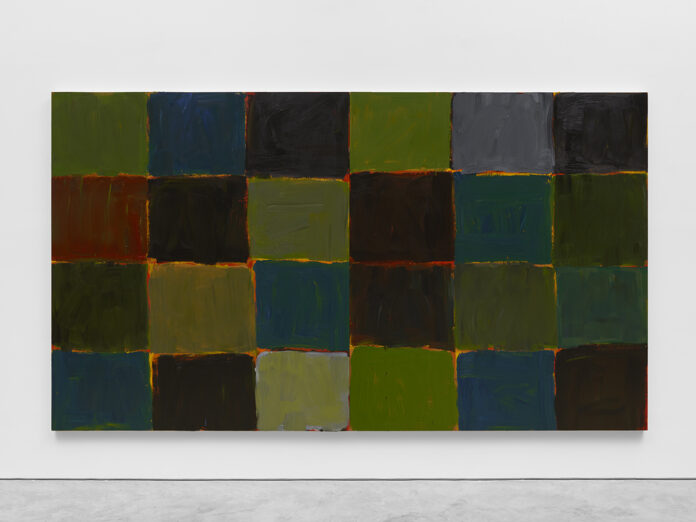Sean Scully, LA Deep show, Lisson Gallery
Los Angeles, September 23-November 4, 2023
by Lorien Suárez-Kanerva
Art Miami Magazine Article
“I undo the authority of the grid
I make the edges tremble
And the color unnameable
All that clarity and certainty
I subvert.”
Sean Scully, Grid, October 9, 2023.
From September 23 to November 4, Lisson Gallery’s LA Deep exhibition draws together five decades of Sean Scully’s paintings. The exhibition comprises new artworks and some of his earlier 1970s paintings from his time in Los Angeles. LA-based art critic Peter Frank drew from Scully’s early history in LA to relate the artist’s nascent fondness for the city. “His first one-person show in the United States was March [1975] in California, at La Tortue, a prominent gallery in Los Angeles. He came out…to open the show and to lecture at universities throughout the state. The warm reception given his show…added to Scully’s enthusiasm…as did his discovery of an active and sophisticated art scene.” Sean Scully held
an opening talk with artist Andy Moses at the gallery about their shared connection to Los
Angeles.
Video credit: ©Sean Scully; Courtesy Lisson Gallery
Scully is a groundbreaking artist. As Arthur C. Danto observed, “Scully’s historical importance lies in the way he has brought the great achievement of Abstract Expressionist painting into the contemporary moment.” Art critic David Carrier likewise affirmed, Scully “moved from being a very skilled minimalist to occupying a powerful position very much all his own.” Scully forged a distinctly original creative path for himself as a painter and for the future of painting itself.
In my conversations with Scully, he reflected on this solitary path. The experience was “existentially deep – I was alone.”
When I painted ‘Backs and Fronts,’ it was a challenge. I was breaking the rules — written by the most important critics. I did it without sense. Because when you placed it against another system, it didn’t make sense. It is necessary to reinvent a way of seeing or accepting it. It was difficult for most. The edges were broken. The proportions didn’t make sense mathematically.
It was a matter of feeling. And the proportions of my body. And the colors were completely intuitive. And that’s why I was breaking all the rules.
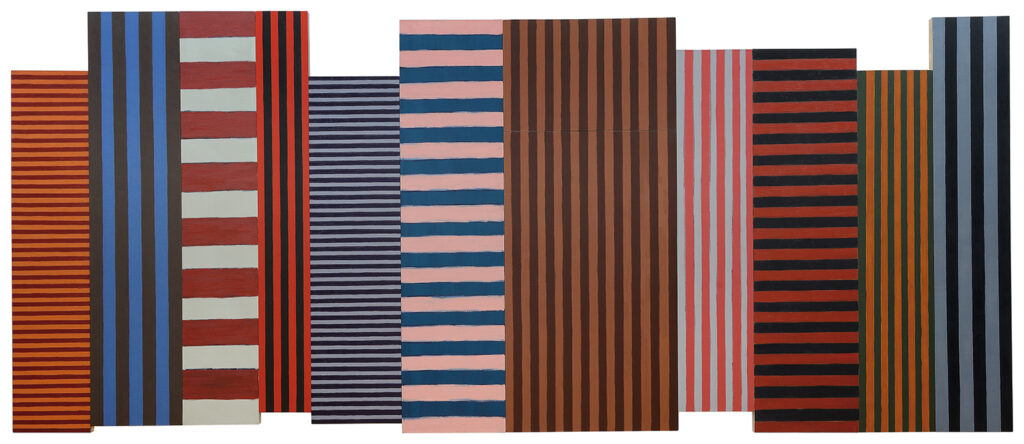
Scully moved away from American Formalism of the 80s and its focus on a “purity of
abstraction and perfection of geometry.” He sought to humanize geometry.
I think of geometry as profound and timeless. And in a sense, the thing that binds us together.
I have a deeply held belief about trying to make geometry speak to people instead of making
them submit to it and the authority of perfection. Impurity makes life inventive, and purity
leads to sterility, so my paintings look the way they look. They’re romantic, moody, and
emotive. Sometimes, there is a lot of melancholia in them, touching on my being Irish and
born on the street.
Scully observed that human relationships and how to be are our central problems now. He
perceives this tension in human relationships as inherent to being human. Sartre’s
“irrevocable three” serves as its reasoning– where, by its very nature, perception grips
irreconcilable tensions upon identity and its definition of and for the self and the other and
their relationships.

Outside by the entrance of the gallery stands Scully’s Stack Colors sculpture. The treatment of its edges placed this way and that without apparent rhyme or reason draws from Scully’s seminal 1981 Backs and Fronts painting. The intuitive arrangement of forms, where squares are layered “before, between, and behind,” posits the question of their relationship to each other in space. It is an essential facet of Scully’s work. The multicolored sediment-like strata
operates like “landlines” building up a composite tower bridging earth and sky. The
“landline” is a distinguishing harmonious element in Scully’s work. It has a romantic quality
assisted by the associations with the parallel arrangement of the horizon and its linkages to
the land, sea, and sky.
Scully found an affinity with Samuel Beckett’s writing: “ash grey sky mirrored earth mirrored sky,” which Scully identified as a parallel composition to his landline paintings.
Upon entry into the gallery’s main exhibition space, Scully’s newest Landline paintings are arranged as a set of triptychs on the right and left side walls. The arrangement emphasizes the relationships and interconnections between his works.

The Landline paintings can also be appreciated in light of Andy Moses’ conversation with Scully about the authority of ruins – addressing how ancient monuments hold material weight through time with their stone structure. Within each work, an inset painting has center stage. Scully described the concept of the inset: “Here are basically two paintings: the painting of a hole and a painting of what fills that hole…Trying to put something into the painting that gives it a human figurative, figural aspect as a metaphor. In these paintings…I am dealing with the figure in the window.” Scully refers to the figure in the window for his appreciation of Matisse’s prevailing use of the motif in his paintings. In connection to the figurative associations Scully creates within his abstract work, art critic Dávid Fehér observed that “the window operates as a crossing point between mimesis and abstraction.”
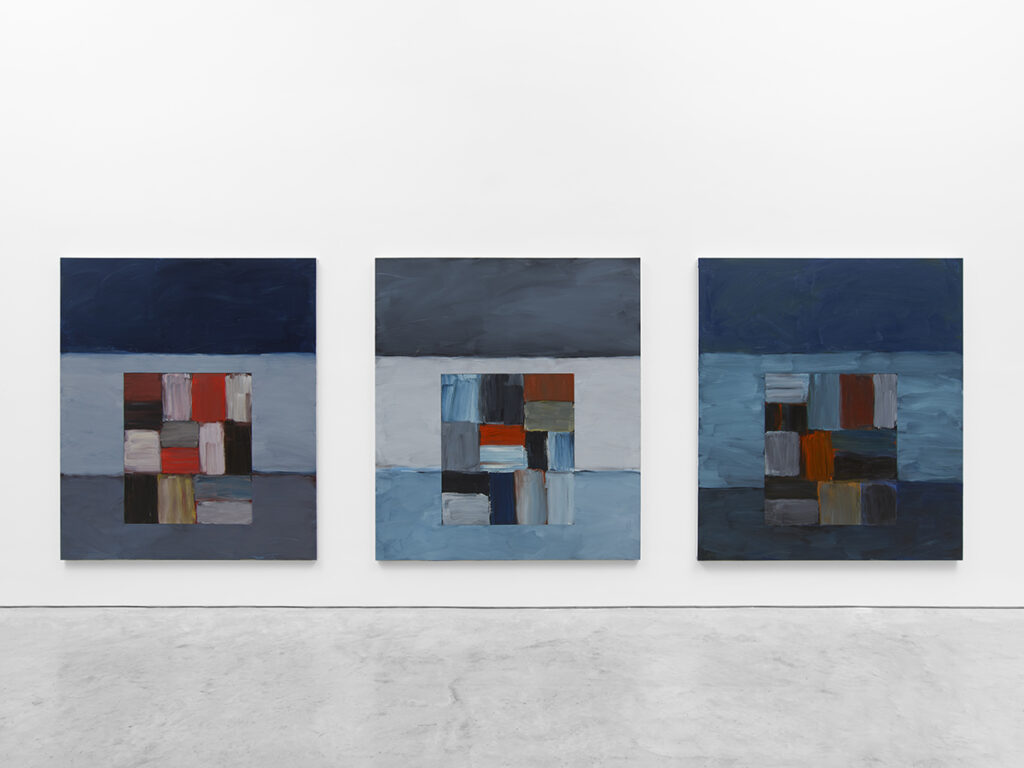
The unorthodox structure of Beckett’s writing appealed to Scully. The painter admired it as “so frontal and real life.” Beckett captured conceptual sensibilities in a statement about his work in a 1959 letter. ‘Holes in paper open and take me fathoms from anywhere”. So also, Scully’s insets transport viewers.
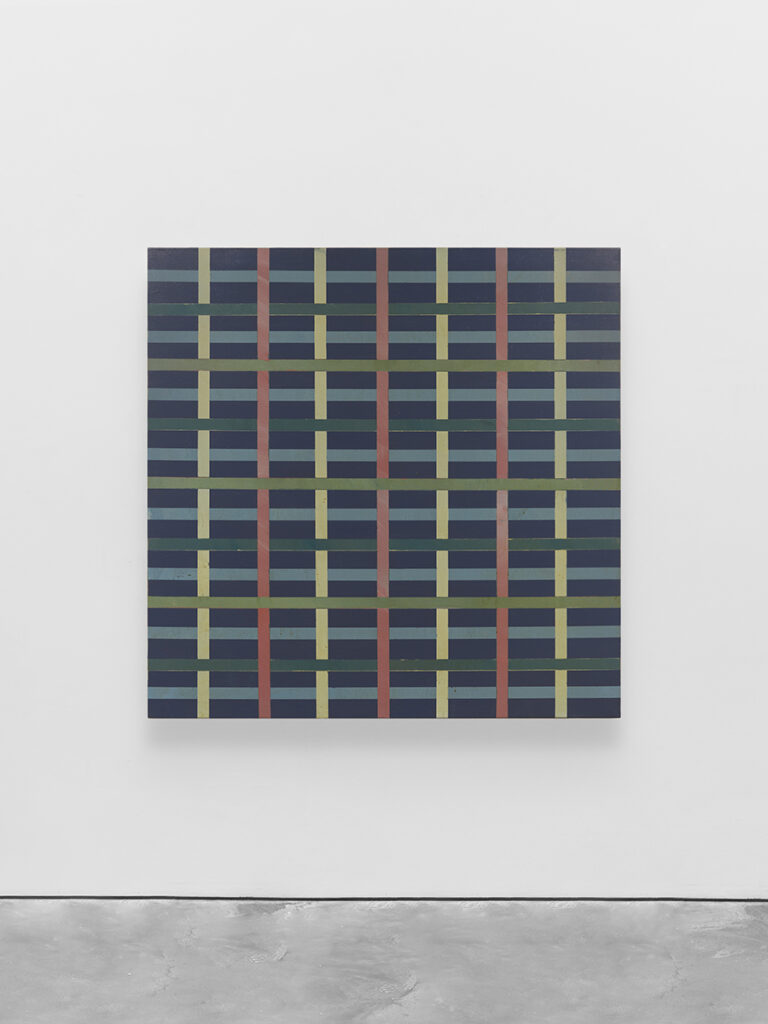
Image 5: (left) Final Grey ½, Acrylic and tape on canvas, 84 x 84 inches, 1974, (right)
Second Order ½, Acrylic on canvas, 60 x 60 inches 1974, ©Sean Scully; Courtesy Lisson
Gallery
Cityscapes and his travels to Morocco in 1969 inspired Scully’s Supergrid paintings. The beauty of numerous multicolored dyed wool strips stretched and laid out as an arrangement appealed to him. Scully also wanted to bring together the energies of Jackson Pollock and Mondrian into his work. “Pollock represented for me a kind of desire and freedom [while] Mondrian represented conscious structure and morality.” Scully recognized a fusion he could contribute from these irreconcilable facets. “I tend to try to work with -both of them- all the time.”
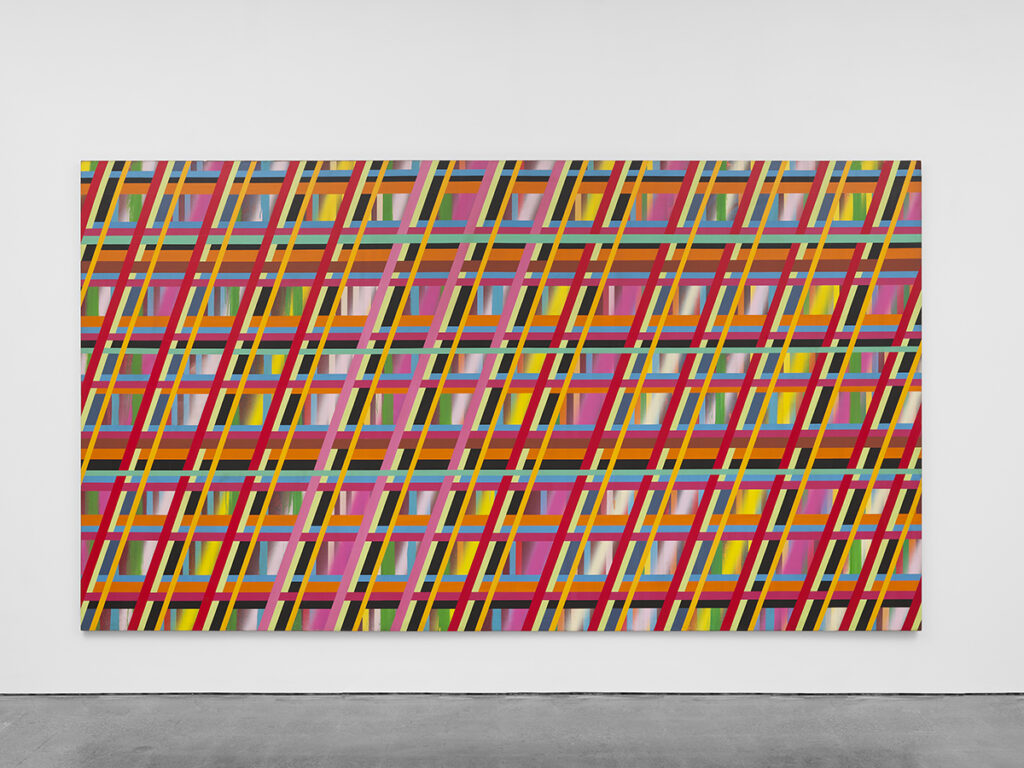
Blaze as a painting beckons on a prominent wall. Employing fast-drying acrylic paint, tape, paintbrush, roller, and a spray gun, Scully created a zig-zagging array of juxtaposed – appearing and reappearing stripes and bands. Scully observed of his Supergrid paintings: “by overlaying systems which are measured differently. They are vertical and horizontal, and layered and layered, until I got to the point where I didn’t think I could put anything else on
without losing all the moves I had made.” This endless symmetry presents neither a beginning nor an end.
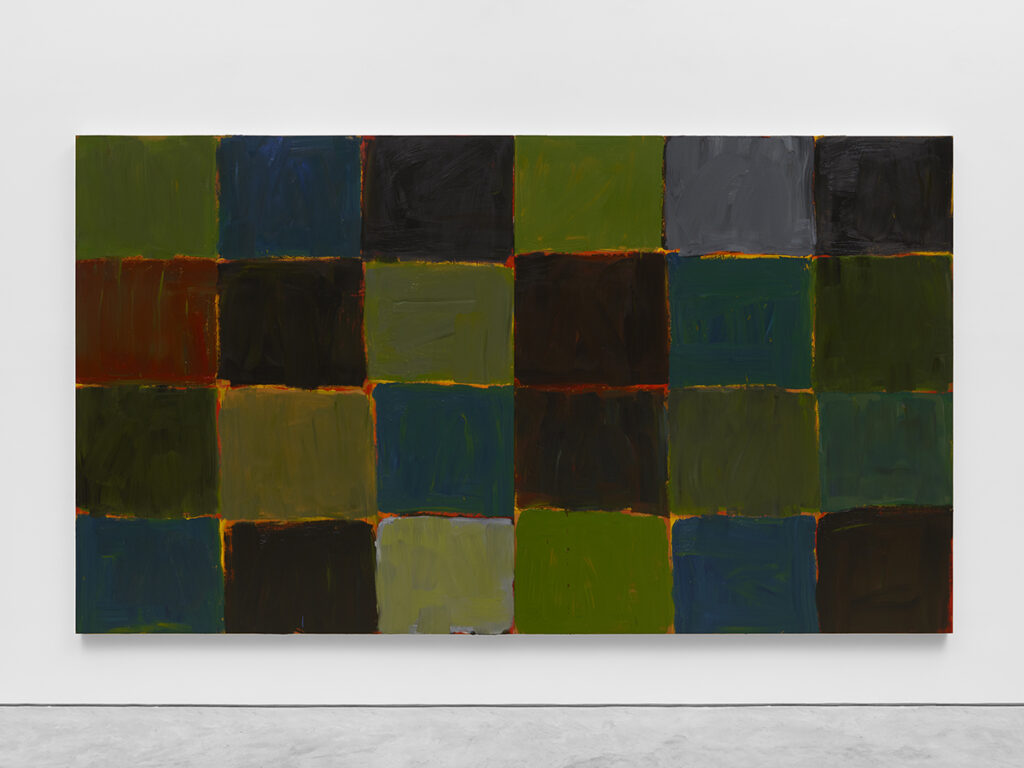
Opposite to Blaze, stalwart Guadalupe’s squares define spaces stripped down to an essential nakedness. Their blockish power, upon closer observation, recedes, revealing inklings into the process, and instances of the artist’s efforts appear as innate idiosyncrasies in the surface and the underlying layering and placement of his rich paint swaths and the layered brushwork contained in these squares. The squares are “folds” in the picture plane. For Scully, “folding metaphorically serves as an allusion to endless regeneration. Artistic culture to me is like a huge rug that is constantly folded and unfolded by us. Every time it is refolded, it grows new secrets, new wonders.”
His Wall of Light paintings (represented with Guadalupe in the exhibition) were inspired by an image of a streaming wall of light that he saw at Chichen Itza. Scully described how the light changed the walls from orange to blue to black, pink in the morning. Fehér describes the effect that the sunlight had on the surface of the stone wall “as simultaneously solid and volatile…the stone walls seem to dissolve in the sunlight, while the sunlight appears to be embodied in the stone wall…but are unified into a harmonious synthesis.” Hidden behind the solid-colored blocks but revealed as their salient electrified edges, an underlying, vivid underpainting appears in the background, acting as a “Wall of Light.”
Scully’s Wall of Light brings to mind French philosopher Simone Weil’s reflections in Gravity and Grace. “Man only escapes from the laws of this world in lightning flashes. Instances when everything stands still, instants of contemplation, of pure intuition…It is through such instances that he is capable of the supernatural. Inspiration apprehended in the moment and revealed by nature appear as liminal windows that open an engagement with the transcendent and can draw forth an expressive form of catharsis.”
In the 80s, Scully returned to painting in oil. His artwork was “painted very directly, very physically… It takes a long time until everything comes together to make a style, to make a way of putting down paint.” Through each stroke placed, textural traces of Sean Scully’s process grant the viewer fissures into the moments of its conception.
Scully’s most recent works were painted on metal. The decision to use it as a surface was based on his work in the 80s with aquatints and etchings. There’s a novel quality that Scully described as “a dull but vibrant light.”
This pressing, caressing action that I make on these big paintings with the motion of my body, gradually changes the colors and their character, to produce a surface unique to painting, and colors that I have not seen before in abstraction.
The character revealed appears in direct alignment with distinct instants, alive with the artist’s
intent and engagement with the medium and the materiality of each artwork.
The painting, the putting down of the paint, is physical and made in layers so that the underpainting subverts what is on top. But what is on top is only the end of a process and the final layer; underneath that final layer is a body that gives a feeling of the history of the handprint of my life, my vision, and my work…The tracks in between the stripes set up a vibration that is a counterpoint to the certainty of the form.
For Scully, the act of painting reveals “structured feelings.” Danto described, the need for “wide brushes and great physical strength to move the nearly viscous pigment and to keep it within boundaries.” Travail is evident in the gestural character of his painting. Scully stated that “I am working, wet on wet, in an emotionally charged state. So I am not looking for clarity. I am looking at emotion”. His paintings mirror Scully’s engagement with an undiluted expressive process sustained by a commanding force.
In our conversation, Scully reflected on his upbringing and how his conception of space was affected by his childhood experiences.
We got an upgrade in Dublin when I needed a birth certificate. We lived with the gypsies, the travelers. When those people are born, they don’t get birth certificates. So, to get a birth certificate, we were fortunate enough to be given a room. The room I have visited since is two meters by two meters down in the cellar with one window. This experience had a psychological impact. I’ve never allowed space into my paintings, or I fill it all up. They are very claustrophobic.
Poignant motifs appear recurrently through his references to windows, doorways, walls, and grids in his paintings.

Color reflects emotion, memory, and experiences of the natural world. Richly chromatic, Dark In holds an earthier sensibility as a painting. Though I am aware that often I fight for color in my work, to assert my connection to the natural world, I actually have no theory about color whatsoever. Afterwards I can always interpret them as active, sad, resolved, awkward, etc., though not when I’m painting them.
Scully appreciates colors he has drawn from his travels.
There are three types of colors in Mexico. It’s very delicate, pale, yellow, grey, and rose in the morning. At night, it is very blue, but a deep blue. And there’s another color sense that’s crazy – of celebrations, costumes, party dresses and ceremonies, and the houses, too. The house is red, but even in the middle or next to the door, if the red is worn, they will use another color immediately next to it that doesn’t make sense. I love this. It’s similar to paintings, especially from the early 80s.
Thoreau’s prayer “not to be in haste to detect the universal law, [but rather] let me see more clearly a particular instance” has echoes distilled through Scully’s artwork and reflections. Scully’s earnest expression takes up recurring and thoroughly humanized motifs of window, the door, folding, layering, and walls. As Scully observed, “I am using the language of the universal to make something personal. And somehow, I believe this approach has more authentic universality and human expression in it.” Appearing as abstract geometric forms, his paintings speak to universally shared human understandings. Patient attentiveness to moments spent in nature, travels, and city life are transmuted with meaning as metaphors brought to life in his work. Half a century “laying down the paint” has built up a seminal testament to Scully’s resilient courage, his intellectual refinement and a brutal streetwise creative grasp of life.


